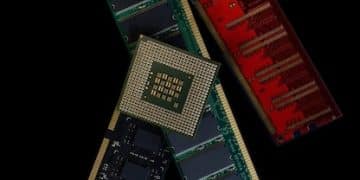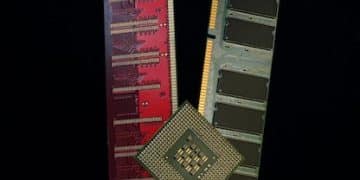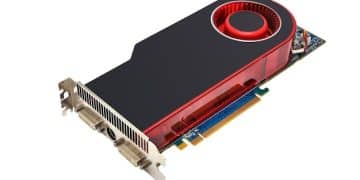AMD FSR: What to Expect in 2025, A Response to DLSS 3.5

AMD’s FidelityFX Super Resolution (FSR) is set to evolve significantly by 2025, potentially leveling the playing field with NVIDIA’s DLSS 3.5 through enhanced upscaling techniques and improved image quality, focusing on broader hardware compatibility and open-source accessibility.
The landscape of gaming and graphics technology is constantly evolving. As NVIDIA’s Deep Learning Super Sampling (DLSS) continues to set benchmarks with its advanced features, the spotlight turns to **AMD’s Response to DLSS 3.5: What to Expect from FidelityFX Super Resolution’s Next Iteration in 2025**. This article provides an in-depth look at AMD’s efforts to compete, innovate, and deliver cutting-edge graphics enhancements.
Understanding the Current State of Upscaling Technologies
Before diving into AMD’s future plans, it’s crucial to grasp the present state of affairs. Upscaling technologies have become essential tools for gamers and developers, allowing for improved performance and visual fidelity. Let’s explore the basics of upscaling.
What is Upscaling?
Upscaling is a technique that renders a game or application at a lower resolution and then intelligently scales it up to match the display’s native resolution. This process reduces the load on the graphics card, improving frame rates.
DLSS vs. FSR: A Head-to-Head Comparison
While both technologies aim to achieve similar goals, they operate differently. NVIDIA’s DLSS utilizes deep learning and AI to upscale images, whereas AMD’s FSR employs spatial upscaling algorithms and is open-source.
- Accessibility: FSR’s open-source nature provides broader compatibility, while DLSS is primarily designed for NVIDIA RTX cards.
- Image Quality: DLSS often provides superior image quality due to its deep learning approach.
- Performance: Both technologies offer significant performance improvements over native resolution rendering.
Currently, DLSS 3.5 includes Ray Reconstruction, which enhances ray-traced visuals by replacing hand-tuned denoisers with an AI network, resulting in improved image clarity. AMD needs to respond with significant advancement to stay competitive.
In conclusion, the present status of upscaling tools demonstrates their critical function in enhancing gaming performance. Technologies such as NVIDIA’s DLSS and AMD’s FSR have distinct characteristics and seek to give better graphics capabilities.

AMD’s FidelityFX Super Resolution: The Journey So Far
AMD’s FidelityFX Super Resolution (FSR) has come a long way since its inception. It has evolved through several iterations, each bringing improvements in image quality and performance. Let’s trace the evolution of AMD FSR.
FSR 1.0: The Debut
The initial release of FSR focused on spatial upscaling, providing a simple yet effective solution to boost frame rates. It was well-received due to its cross-platform compatibility.
FSR 2.0 and Beyond: Temporal Upscaling
Later versions of FSR introduced temporal upscaling, leveraging information from previous frames to enhance image quality. This resulted in sharper, more detailed visuals compared to FSR 1.0.
AMD has made significant strides with each iteration of FSR, but the gap with DLSS remains a challenge. To compete effectively, AMD needs to innovate further, particularly in areas such as AI-driven enhancements and ray tracing.
In summary, AMD’s development of FidelityFX Super Resolution (FSR) has been characterized by ongoing improvements. The differences between versions highlight AMD’s dedication to improving image quality and performance.
What DLSS 3.5 Offers: A Benchmark for AMD
NVIDIA’s DLSS 3.5 introduces several groundbreaking features that set a high standard for upscaling technologies. Understanding these features is crucial to assessing AMD’s response. We’ll look at key advancements DLSS 3.5 provides.
Ray Reconstruction: AI-Powered Ray Tracing
DLSS 3.5 features **Ray Reconstruction**, replacing traditional denoisers with an AI network trained to recognize ray-traced patterns. This results in superior image quality in ray-traced environments.
Frame Generation: Boosting FPS
Frame Generation is another key feature, using AI to generate entirely new frames, significantly increasing frame rates in supported games. This helps gamers with older hardware enjoy higher frame rates.
- Enhanced Visuals: DLSS 3.5 dramatically improves image clarity, especially in ray-traced scenes.
- Performance Boost: Frame Generation provides substantial FPS gains, enhancing the gaming experience.
- Advanced AI: The use of AI allows for more intelligent upscaling and frame generation.
DLSS 3.5 excels by combining AI advancements with effective upscaling and frame creation, resulting in excellent graphical performance. To effectively respond, AMD must close this gap.
In conclusion, NVIDIA’s DLSS 3.5 delivers advanced features, particularly Ray Reconstruction and Frame Generation, that greatly improve image quality and performance. These advancements set a considerable standard for AMD to surpass.
Potential Areas of Improvement for AMD FSR
To effectively compete with DLSS 3.5, AMD needs to focus on key areas for improvement in future iterations of FSR. Let’s see where AMD should focus.
AI Integration
Integrating AI into FSR could significantly enhance its upscaling capabilities, allowing for more intelligent and adaptive image reconstruction.
Ray Tracing Optimization
Optimizing FSR for ray tracing is crucial, as ray-traced environments demand high-performance upscaling to maintain playable frame rates.

AMD should prioritize AI-driven advancements and superior ray tracing performance in future FSR versions to remain competitive. This will include investigating new algorithms and architectures.
- Increased Image Quality: AI can help FSR produce images nearly indistinguishable from native resolution.
- Improved Ray Tracing: Optimizing FSR for ray tracing will make high-fidelity visuals more accessible.
- Greater Efficiency: AI can optimize upscaling processes, leading to improved performance.
In summary, AMD can compete more effectively with NVIDIA’s DLSS by integrating AI into FSR and fine-tuning ray tracing performance. These capabilities will enable AMD to provide better images.
What to Expect from FSR in 2025: Predictions and Possibilities
Looking ahead to 2025, several possibilities could shape the next iteration of AMD’s FidelityFX Super Resolution. Analyzing patterns and technological improvements yields valuable insights into what to anticipate.
Enhanced Temporal Stability
Future versions of FSR could improve temporal stability, reducing ghosting and artifacts that can occur in fast-moving scenes.
Broader Hardware Support
AMD continues to focus on ensuring wide hardware compatibility, making FSR accessible to a broader range of users, including those with older GPUs.
Anticipated FSR enhancements in 2025 include increased temporal stability and broader hardware compatibility, improving the user experience. These enhancements will enable more consumers to enjoy high-fidelity visuals.
The ongoing improvement of temporal stability and the continuation of extensive hardware compatibility are critical goals.
Strategic Implications for AMD
AMD’s strategic response to DLSS 3.5 carries significant implications for the company’s position in the graphics card market. AMD must strike a balance between rapid innovation, open-source ideals, and customer happiness in order to retain its competitiveness.
Balancing Innovation and Accessibility
While pushing the boundaries of upscaling technology, AMD needs to maintain FSR’s open-source nature and ensure compatibility across a wide range of hardware.
Competitive Positioning
A successful response to DLSS 3.5 could solidify AMD’s position as a major player in the graphics card market, attracting gamers and developers alike.
As graphics technologies develop, AMD intends to emphasize open standards and widespread compatibility. AMD seeks to ensure that more consumers may benefit from enhanced gaming performance.
- Market Share: Improving FSR can assist AMD in increasing its market share.
- Developer Relations: Attracting developers to use FSR will improve adoption and ecosystem growth.
- User Satisfaction: Providing a high-quality upscaling solution increases customer loyalty.
In conclusion, AMD’s future strategy response has far-reaching implications for the company’s role and competitiveness in the graphics card market. AMD’s dedication and open-source approach would be critical to realizing competitive advantages.
| Key Point | Brief Description |
|---|---|
| 🚀 FSR’s Evolution | AMD’s journey in improving FSR’s image quality and performance. |
| 💡 DLSS 3.5 Features | Advanced features like Ray Reconstruction and Frame Generation. |
| 🎯 Areas for FSR Improvement | Prioritizing AI integration and ray tracing optimization. |
| 🔮 FSR in 2025 | Expectations for enhanced temporal stability and broader hardware support. |
FAQ
▼
AMD FidelityFX Super Resolution (FSR) is an upscaling technology developed by AMD designed to boost frame rates in games while maintaining reasonable image quality. It works by rendering the game at a lower resolution and then upscaling it to fit the display.
▼
FSR primarily uses spatial upscaling techniques and is open-source, making it compatible with a wide range of GPUs. DLSS, on the other hand, leverages deep learning and AI for upscaling, providing potentially better image quality but is mainly for NVIDIA RTX cards.
▼
In 2025, expect FSR to include enhanced temporal stability, reducing ghosting and artifacts. It may also feature stronger AI integration for better upscaling and ray tracing optimization, as well as broader hardware support for older GPUs.
▼
AI integration can significantly enhance FSR’s upscaling capabilities, allowing for more intelligent and adaptive image reconstruction. This leads to improved image quality, making it nearly indistinguishable from native resolution, while optimizing performance and efficiency.
▼
DLSS 3.5’s Ray Reconstruction enhances ray-traced visuals using AI, setting a high standard for upscaling technologies. This puts pressure on AMD to innovate further, especially in AI-driven enhancements and ray tracing optimization, to remain competitive.
Conclusion
In conclusion, as we look towards 2025, AMD’s response to NVIDIA’s DLSS 3.5 will be crucial in shaping the future of gaming graphics. By focusing on AI integration, ray tracing optimization, and broader hardware support, AMD can potentially deliver a compelling alternative that appeals to a wide range of gamers and developers, reinforcing its position in the competitive graphics card market.





